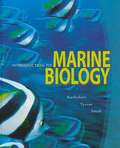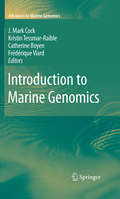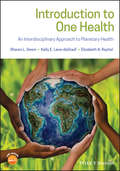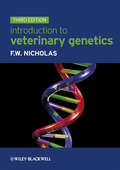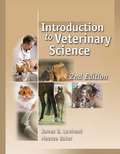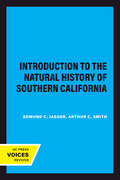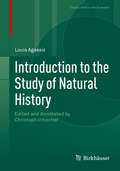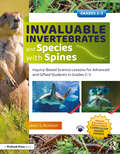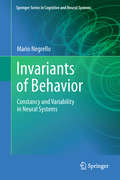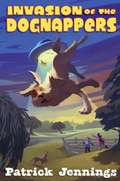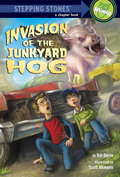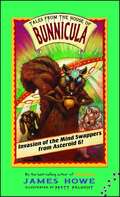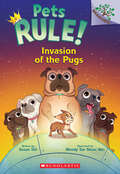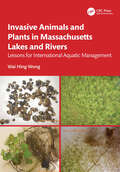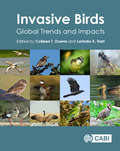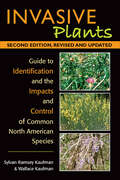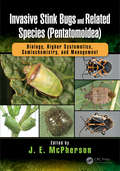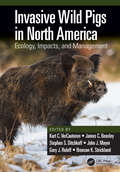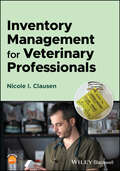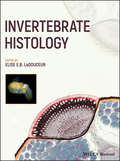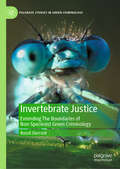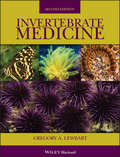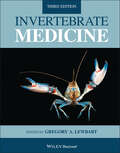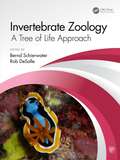- Table View
- List View
Introduction to Livestock and Companion Animals
by Austin M. Bull Jasper S. Lee Jim Hutter Lyle Westrom Rick Rudd Chris Embry Mohr Jody PollockIntroduction to Livestock and Companion Animals has been revised to serve as an outstanding introductory textbook in animal science. It is about far more than cattle, swine, and chickens--though these are included. It integrates a multitude of perspectives on animal education. Basics of biology are included as the foundation for animal education. Practical connections are addressed in each chapter. Biotechnology has been expanded throughout.
Introduction to Marine Biology, 3rd edition
by George Karleskint James W. Small Richard TurnerImmerse yourself in INTRODUCTION TO MARINE BIOLOGY and quickly learn the content of the course. While taking an ecological approach, this biology text provides succinct coverage of the content while the photos and art work clearly illustrates key concepts. Studying is made easy with phonetic pronunciations, a running glossary of key terms, end-of-chapter questions, and websites provided at the end of the chapter, and lists of related articles found throughout the text.
Introduction to Marine Genomics
by Kristin Tessmar-Raible J. Mark Cock Frédérique Viard Catherine BoyenMarine biology has always played an important role in biological research, being at the origin of many key advances. To a certain extent, the influence of marine biology on the biological sciences was overshadowed over a period of several years by the remarkable advances that were made using powerful model organisms from terrestrial environments. This situation is now changing again, however, due primarily to spectacular developments in genomic methodologies that have significantly accelerated research in a broad spectrum of marine biology disciplines ranging from biodiversity to developmental biology to biotechnology. The data generated by marine genomics projects have had an impact on questions as diverse as understanding planetary geochemical cycles, the impact of climate change on marine fauna and flora, the functioning of marine ecosystems, the discovery of new organisms and novel biomolecules, and investigation of the evolution of animal developmental complexity. This book represents the first attempt to document how genomic technologies are revolutionising these diverse domains of marine biology. Each chapter of this book looks at how these technologies are being employed in a specific domain of marine research and provides a summary of the major results obtained to date. The book as a whole provides an overview of marine genomics as a discipline and represents an ideal starting point for exploring this rapidly developing domain.
Introduction to One Health: An Interdisciplinary Approach to Planetary Health
by Sharon L. Deem Kelly E. Lane-deGraaf Elizabeth A. RayhelIntroduction to One Health: An Interdisciplinary Approach to Planetary Health offers an accessible, readable introduction to the burgeoning field of One Health. Provides a thorough introduction to the who, what, where, when, why, and how of One Health Presents an overview of the One Health movement viewed through the perspective of different disciplines Encompasses disease ecology, conservation, and veterinary and human medicine Includes interviews from persons across disciplines important for the success of One Health Includes case studies in each chapter to demonstrate real-world applications
Introduction to Veterinary Genetics
by Frank W. NicholasThe concepts of veterinary genetics are crucial to understanding and controlling many diseases and disorders in animals. They are also crucial to enhancing animal production. Accessible and clearly presented, Introduction to Veterinary Genetics provides a succinct introduction to the aspects of genetics relevant to animal diseases and production. Now in its third edition, this is the only introductory level textbook on genetics that has been written specifically for veterinary and animal science students.Coverage includes: basic genetics, molecular biology, genomics, cytogenetics, immunogenetics, population genetics, quantitative genetics, biotechnology, and the use of molecular tools in the control of inherited disorders. This book describes in detail how genetics is being applied to artificial selection in animal production. It also covers the conservation of genetic diversity in both domesticated and wild animals.New for the Third Edition:End-of-chapter summaries provide quick recaps.Covers new topics: epigenetics, genomics and bioinformatics.Thoroughly revised according to recent advances in genetics.Introduction to Veterinary Genetics is still the only introductory genetics textbook for students of veterinary and animal science and will continue to be an indispensable reference tool for veterinary students and practitioners alike.
Introduction to Veterinary Science
by James B. Lawhead Meecee BakerAn introductory level text which begins with basic cell biology and tissue function, followed by the musculoskeletal, circulatory, respiratory, renal, digestive, reproductive, nervous, endocrine, and immune systems. Nutrition and diseases are covered in depth, including infectious disease principles, prevention, classification, zoonoses, and diagnosis. The final section addresses surgery. Appendices address decision-making and veterinary careers, and provide a glossary. Cases are discussed throughout, with color photographs, diagrams, and charts. (We contemn the 2005 copyright date in a book that is out in August 2003) Annotation (c)2003 Book News, Inc. , Portland, OR (booknews. com)
Introduction to the Natural History of Southern California (California Natural History Guides #13)
by Edmund C. Jaeger Arthur C. SmithThis title is part of UC Press's Voices Revived program, which commemorates University of California Press’s mission to seek out and cultivate the brightest minds and give them voice, reach, and impact. Drawing on a backlist dating to 1893, Voices Revived makes high-quality, peer-reviewed scholarship accessible once again using print-on-demand technology. This title was originally published in 1966.This title is part of UC Press's Voices Revived program, which commemorates University of California Press’s mission to seek out and cultivate the brightest minds and give them voice, reach, and impact. Drawing on a backlist dating to 1893, Voices Revived</DIV
Introduction to the Study of Natural History
by Christoph Irmscher Louis AgassizThis book features Louis Agassiz’s seminal lecture course in which the Swiss-American scientist, a self-styled “American Humboldt,” summarized the state of zoological knowledge in his time. Though Darwin’s theory of evolution would soon dismantle his idealist science, Agassiz’s lectures are nonetheless modern in their insistence on the social and cultural importance of the scientific enterprise.An extensive, well-illustrated introduction by Agassiz’s biographer, Christoph Irmscher, situates Agassiz’s lectures in the context of his life and nineteenth-century science, while also confronting the deeply problematic aspects of his legacy. Profusely annotated, this edition offers fascinating insights into the history of science and appeals to anyone with an interest in zoology and natural history. “Christoph Irmscher provides a scholarly and insightful analysis of the intentions and beliefs of Louis Agassiz, a larger-than-life scientist of the mid-19th century and fierce opponent of Charles Darwin. One of the foremost naturalists of his time, Agassiz’s encyclopedic knowledge and brash confidence sustained bold and often controversial theories, which contributed to extreme intellectual ferment at the dawn of contemporary evolutionary biology.” James Hanken, Alexander Agassiz Professor of Zoology, Harvard University, USA
Invaluable Invertebrates and Species with Spines: Inquiry-Based Science Lessons for Advanced and Gifted Students in Grades 2-3
by Jason S. McIntoshRecipient of the 2022 NAGC Curriculum AwardInspire the next generation of zoologists with this 30-lesson interdisciplinary science unit geared toward second and third grade high-ability students.Using problem-based learning scenarios, this book helps students develop the vocabulary, skills, and practices of zoologists as they conduct research and solve real world problems. Students will gain an in-depth understanding of how the animal kingdom is structured, create an innovative zoo exhibit containing an entire ecosystem for a vertebrate animal of their choosing, design invertebrate animal trading cards, and much, much more. Featuring detailed teacher instructions and reproducible handouts, this unit makes it easy for teachers to adjust the rigor of learning tasks based on students’ interests and needs.Aligned with Common Core State Standards for English Language Arts and Mathematics plus the Next Generation Science Standards, gifted and non-gifted teachers alike will find this expedition into the animal kingdom engaging, effective, and highly adaptable.
Invariants of Behavior
by Mario NegrelloThe study of the brain and behavior is illuminated with the discovery of invariances. Experimental brain research uncovers constancies amidst variation, with respect to interventions and transformations prescribed by experimental paradigms. Place cells, mirror neurons, event related potentials and areas differentially active in fMRI, all illustrate the pervasive role of invariances in neural systems in relation to their function.
Invasion of the Dognappers
by Patrick JenningsWhen dogs go missing, one boy will find out why. And the answer is out of this world. Nothing gets past Logan. When he observes that the neighborhood’s dogs are mysteriously vanishing, he suspects nothing less than a full-scale alien dognapping invasion. The adults don’t believe him, of course, so he enlists his friends to investigate and soon they make a shocking discovery. Now man’s best friend needs help. Fast. Suddenly, Logan and his team are on a mission unlike anything known to man. A hilarious, heartwarming tale of hound-saving heroics,Invasion of the Dognapperswill be gobbled up by middle-grade readers. Ages 8-12
Invasion of the Junkyard Hog
by Bill Doyle Scott AltmanFollowing Attack of the Shark-Headed Zombie and Stampede of the Supermarket Slugs is Bill Doyle's third tale of monsters and magic. Mr. Cigam has a new job for Keats and Henry--a job working for his mixed-up stepsisters, Lillian and Beatrice. The sisters have lost a magical compass at the Tophat Junkyard, and ever since then, they've lost their sense of direction as well. Now they need pleh! (That's help spelled backward.) But for Keats and Henry, finding the compass isn't going to be easy. Something else is searching for it, too--a magic-sniffing junkyard hog with wings, long sharp tusks, and an appetite for destruction!
Invasion of the Mind Swappers from Asteroid 6! (Tales from the House of Bunnicula #2)
by James Howe Brett HelquistDear possible reader of this book,<P> After I wrote my first book, It Came from Beneath the Bed!, my editor asked me to write another one. (Another one! This is hard work! I'd like to see him write another one!) So anyway...in this book the lovable and smart (not to mention talented) wirehaired dachshund puppy named Howie and his friend, the beautiful and brilliant Delilah, face their biggest challenge yet: the Mind Swappers from Asteroid 6!™ Along the way Delilah gets turned into a squirrel and has to beg for acorns. (Hey, don’t ask me! Read the book!)<P> Your friend, Howie
Invasion of the Pugs: A Branches Book (Pets Rule!)
by Susan TanEmber and the other pets come face-to-face with their most mysterious enemy yet: a pack of pugs!Pick a book. Grow a Reader!This series is part of Scholastic's early chapter book line, Branches, aimed at newly independent readers. With easy-to-read text, high-interest content, fast-paced plots, and illustrations on every page, these books will boost reading confidence and stamina. Branches books help readers grow!Ember is all ready for doggy daycare! At first, he's excited to go to the park every day because he'll be able to rule and conquer the dog park in no time. But when the dog walker arrives to pick him up, Ember comes face-to-face with the strangest-looking dogs on the planet: PUGS! Ember keeps his distance from the mysterious creatures until he learns a terrible secret: the pugs are aliens trying to take over the Earth! Will Ember and the other pets be able to stop an evil invasion of the pugs? With laugh-out-loud humor, engaging artwork on every page, and nonstop action that will have readers rushing to turn the pages, Pets Rule! is the just-right series for any emerging reader!
Invasive Animals and Plants in Massachusetts Lakes and Rivers: Lessons for International Aquatic Management
by Wai Hing WongThere is a growing demand for appropriate management of aquatic invasive species in lakes and rivers worldwide. This book covers biology, invasion ecology, sightings, and control techniques of 4 invasive animals and 15 invasive plants in Massachusetts lakes and rivers. It provides valuable information on their biological characteristics and potential expansion pathways, as well as monitoring and management, including alternative management tools using updated biological, chemical, and mechanical methods. The book also includes the regulation of invasive species management to allow resource managers, biologists, practitioners, volunteers, and students a better understanding of compliance and enforcement with environmental law. An example of successful management is highlighted for each invasive species. Invasive Animals and Plants in Massachusetts Lakes and Rivers is the first book to provide comprehensive and systematic coverage and illustrations for both freshwater invasive animals and plants. Although focussing on Massachusetts, it will provide readers with the bigger picture on multiple invasive species, from prevention, early detection, control, ecological restoration, to public education. Natural resource managers in Massachusetts and surrounding states will glean the detailed and valuable information they need to learn and use to prevent and manage freshwater invasive species in the field.
Invasive Birds: Global Trends and Impacts
by Matthew Burnett Bill Pranty Diederik Strubbe Erik Matthysen Matthieu Guillemain Johan Elmberg Iain Henderson Ding Li Yong Juan Carlos Reboreda Alexander Cruz Tim Adriaens Craig R Allen Michael L Avery Alexander V Badyaev Fabrice M Brescia Sarah E Britton Daniel M Brooks Jessica L. Burnett Corey T Callaghan César Capinha Jen Cele Jameson F Chace Jocelyn Champagnon Alice Cibois Andrew Close Alyssa R Conn Richard T Corlett Adrian J Craig Amy E Dunham James A Eaton David A Smith Yvette C Smith Mike W Eichholz Cyril Eraud Chris L Feare Jason M Gleditsch Guillaume G Gayet Carlos Gutiérrez-Expósito Haley E Hanson Frank Huysentruyt John G Innes Salit Kark Michael R Leven Ricardo J Lopes Jean-Francois Maillard Ndivhuwo Maligana Chloe I Marcheli Lynn B Martin Blake A Mathys Myriam E Mermoz Jean-Yves Meyer Dai K Morgan Katherine G Ohman Claire Pernollet Murray A Potter Eileen C Rees Luís Reino Joana Ribeiro Peter A Robertson Andrew M Rogers Philip D Round Joana Santana Cavin T Shivambu Neftalí Sillero Preshnee Singh Pär Söderquist Karina L Speziale Martin J Sullivan Jean-Claude Thibault Martin Thibault Berndt J van Rensburg Eric Vidal Joseph R Waas Amy-Leigh Wilson Katherine Winston Kevin A Wood Pierre Yésou Jaime E ZolikExamining globally invasive alien birds, the first part of this book provides an account of 32 global avian invasive species (as listed by the Invasive Species Specialist Group, ISSG). It acts as a one stop reference volume; it assesses current invasive status for each bird species, including details of physical description, diet, introduction and invasion pathways, breeding behaviour, natural habitat. It also looks at the environmental impact of each species, as well as current and future control methods. Full colour photographs assist with species identification and global distribution maps give a visual representation of the current known distributions of these species. The second part of the book discusses the biogeographical aspects of avian invasions, highlighting current and emerging invasive species across different regions of the world. The third section considers the impact of invasive species on native communities, problems associated with invasive bird management and the use of citizen science in the study of invasive birds.
Invasive Plants: Guide to Identification and the Impacts and Control of Common North American Species
by Wallace Kaufman Sylvan Ramsey KaufmanNewly updated: &“Invasive plants are ecological tumors that degrade food webs wherever they go. The third edition of [this book] is an invaluable reference.&” —Douglas Tallamy, New York Times–bestselling author of Nature&’s Best Hope This easy-to-use, wide-ranging guide to invasive plants in North America features full-color photos and descriptions of more than 250 alien species—both terrestrial and aquatic—that are in some cases changing the landscape to an almost unimaginable degree. Accompanying text describes the plant&’s environmental and economic impacts as well as management techniques used to control it. Also included is an explanation of what an invasive is and a step-by-step identification key. Used by U.S. Forest Service botanists, this is an essential guide to understanding this unprecedented environmental challenge that is threatening biodiversity—and the human population that depends on it to survive. &“A colorful, general field guide to the major invasive plants of North America…packed with relevant information.&” —Great Plains Research: A Journal of Natural and Social Sciences &“A wonderful guide.&” —The Roanoke Star
Invasive Stink Bugs and Related Species: Biology, Higher Systematics, Semiochemistry, and Management (Contemporary Topics in Entomology)
by J. E. McPhersonKey features: Presents a brief history of past classifications, a summary of present classification, and speculation on how the classification may evolve in the future Includes keys for the identification of families and subfamilies of the Pentatomoidea and for the tribes in the Pentatomidae Explains transmission of plant pathogens and concepts of pathology and heteropteran feeding for the non-specialist Provides an extensive literature review of transmission by stink bugs of viral, bacterial, fungal, and protozoan organisms that cause diseases of plants Discusses the diversity of microbial symbionts in the Pentatomidae and related species, showing how microorganisms underpin the evolution of this insect group Reviews semiochemicals (pheromones, kairomones, allomones) of the Pentatomoidea and their vital role in the life histories of pest and beneficial species and their exploitation by natural enemies of true bugs Covers past, current, and future control options for insects, with a focus on stink bugs and related heteropterans The Superfamily Pentatomoidea (stink bugs and their relatives) is comprised of 18 families with over 8,000 species, the largest of which is the family Pentatomidae (about 5,000 species). These species primarily are phytophagous, and many cause tremendous economic damage to crops worldwide. Within this superfamily are six invasive species, two that occur worldwide and four that are recent invaders in North America. Once established in new geographic regions, these species have increased their numbers and geographic distributions dramatically, causing economic damage totaling billions of dollars. Invasive Stink Bugs and Related Species (Pentatomoidea): Biology, Higher Systematics, Semiochemistry, and Management is the first book that presents comprehensive coverage of the biology of invasive pentatomoids and related true bug species and addresses issues of rapidly growing economic and environmental concerns. Containing the contributions of more than 60 stink bug specialists from 15 countries, this book provides a better understanding of the biology and economic importance of these invasive species, why they became invasive, and how their continued geographical expansion is likely to affect numerous agricultural systems and natural environments. Including over 3,500 references, this authoritative work serves as an access point to the primary literature on their life histories, higher systematics, diapause and seasonal cycles, pathogens, symbionts, semiochemistry, and pest management control strategies for pentatomoid bugs.
Invasive Wild Pigs in North America: Ecology, Impacts, and Management
by Kurt C. VerCauteren James C. Beasley Stephen S. Ditchkoff John J. Mayer Gary J. Roloff Bronson K. StricklandThroughout North America, non-native wild pigs have become an ecologically and economically destructive invasive species. Though they are regarded as a popular game species by some, provide economic benefits to others, and are even engrained into societal heritage in some areas, wild pigs are responsible for an extraordinary amount of damage in both natural and anthropogenic systems throughout North America. As the density and range of wild pig habitat have substantially increased over the last several decades, the magnitude and diversity of their negative impacts are not yet fully realized or quantified. With various conflicts continually emerging, wild pig management is difficult and expensive to achieve. As a result, wild pigs represent one of the greatest wildlife management challenges North America faces in the 21st century. Invasive Wild Pigs in North America: Ecology, Impacts, and Management addresses all aspects of wild pig biology, ecology, damage, and management in a single comprehensive volume. It assimilates and organizes information on the most destructive introduced vertebrate species in the United States, establishing a foundation from which managers, researchers, policy makers, and other stakeholders can build upon into the future. The book provides comprehensive coverage of wild pig biology and ecology, techniques for management and research, and regional chapters. It is an asset to readers interested in wild pigs, the resources they impact, and how to mitigate those impacts, and establishes a vision of the future of wild pigs in North America. Features: Compiles valuable knowledge for a broad audience including wild pig managers, researchers, adversaries, and enthusiasts from across North America Addresses taxonomy, morphology, genetics, physiology, spatial ecology, population dynamics, diseases and parasites, and the naturalized niche of wild pigs Includes chapters on damage to resources, management, research methods, human dimensions and education, and policy and legislation Contains full color images and case studies of interesting and informative situations being created by wild pigs throughout North America Includes a chapter on wild pigs at the wildland–urban interface, a more recent and especially challenging issue
Inventory Management for Veterinary Professionals
by Nicole I. ClausenImplement an effective and efficient inventory management system in your veterinary practice using this practical and concrete guidance Inventory Management for Veterinary Professionals provides a thorough introduction to the logistics of effective and efficient veterinary inventory management. Designed for any employee of a veterinary practice, the book covers strategies and tactics for all major aspects of inventory management. It provides veterinary professionals with a practical roadmap for this key business operation, with stories drawing on the author’s experience to provide a real-world perspective. Emphasizing both the ‘how’ and the ‘why’ of developing effective inventory management systems, it’s an indispensable tool for veterinary professionals at every level of practice. Taking a holistic approach to setting up, maintaining, and optimizing an inventory system, the book begins by describing the theory and strategies for inventory management, then discusses how to incorporate this knowledge into practice. Inventory Management for Veterinary Professionals offers: Detailed discussion of topics including the flow of inventory through the practice, forecasting, ordering, troubleshooting, and moreAdvice on how to receive and restock, organize, price, and sell inventoryGuidance on how to set up an inventory action planA chapter on setting and executing inventory management protocols around controlled substancesA companion website with additional tools, resources, and self-assessment questions Inventory Management for Veterinary Professionals is ideal for any veterinary professional, including practice managers, receptionists, assistants, technicians, and practice owners.
Invertebrate Histology
by Elise E.B. LaDouceurThe first comprehensive reference to invertebrate histology Invertebrate Histology is a groundbreaking text that offers a comprehensive review of histology in invertebrates. Designed for use by anyone studying, diagnosing, or researching invertebrates, the book covers all major taxonomic groups with details of the histologic features, with color photographs and drawings that clearly demonstrate gross anatomy and histology. The authors, who are each experts in the histology of their respective taxa, bring together the most recent information on the topic into a single, complete volume. An accessible resource, each chapter focuses on a single taxonomic group with salient gross and histologic features that are clearly described in the text and augmented with color photographs and greyscale line drawings. The histologic images are from mostly hematoxylin and eosin stained microscopic slides showing various organ systems at high and low magnification. In addition, each chapter provides helpful tips for invertebrate dissection and information on how to process invertebrates for histology. This important book: Presents detailed information on histology of all major groups of invertebrates Offers a user-friendly text that is organized by taxonomic group for easy reference Features high-quality color photographs and drawings, with slides showing histology and gross photographs to demonstrate anatomy Provides details on invertebrate dissection and processing invertebrates for histology Written for veterinary pathologists, biologists, zoologists, students, and other scientists studying these species, Invertebrate Histology offers the most updated information on the topic written by over 20 experts in the field.
Invertebrate Justice: Extending The Boundaries of Non-Speciesist Green Criminology (Palgrave Studies in Green Criminology)
by Russil DurrantInvertebrates are the neglected majority of the animal world. Even though they make up over 95% of animal life, they rarely feature in discussions of speciesism, animal ethics or species justice. This book aims to extend the work of non-speciesist criminologists to argue for the idea of ‘invertebrate justice’. Utilizing green criminologist Rob White’s (2013) eco-justice perspective, the book demonstrates how our interactions with invertebrate species (insects, crustaceans, molluscs and so forth) cause a significant amount of harm to those animals themselves (species justice), the ecosystems in which they are embedded (ecological justice), and ultimately to humans (environmental justice). Across three sections, it provides an overview of the ways in which humans and invertebrates interact across a diverse range of contexts and reviews the literature on both invertebrate biodiversity and invertebrate sentience; builds a theoretical framework that can help us understand what invertebrate justice might mean; and tackles the difficult question of how best we can promote invertebrate justice in the future. It appeals to academics, environmental scientists, activists and policymakers.
Invertebrate Medicine
by Gregory A. LewbartInvertebrate Medicine, Second Edition offers a thorough update to the most comprehensive book on invertebrate husbandry and veterinary care. Including pertinent biological data for invertebrate species, the book’s emphasis is on providing state-of-the-art information on medicine and the clinical condition. Invertebrate Medicine, Second Edition is an invaluable guide to the medical care of both captive and wild invertebrate animals. Coverage includes sponges, jellyfish, anemones, corals, mollusks, starfish, sea urchins, crabs, crayfish, lobsters, shrimp, hermit crabs, spiders, scorpions, and many more, with chapters organized by taxonomy. New chapters provide information on reef systems, honeybees, butterfly houses, conservation, welfare, and sources of invertebrates and supplies. Invertebrate Medicine, Second Edition is an essential resource for veterinarians in zoo animal, exotic animal and laboratory animal medicine; public and private aquarists; and aquaculturists.
Invertebrate Medicine
by Gregory A. LewbartPresented in full color for the first time, Invertebrate Medicine is the definitive resource on husbandry and veterinary medicine in invertebrate species. Presenting authoritative information applicable to both in-human care and wild invertebrates, this comprehensive volume addresses the medical care and clinical condition of most important invertebrate species—providing biological data for sponges, jellyfish, anemones, snails, sea hares, corals, cuttlefish, squid, octopuses, clams, oysters, crabs, crayfish, lobsters, shrimp, hermit crabs, spiders, scorpions, horseshoe crabs, honey bees, butterflies, beetles, sea stars, sea urchins, sea cucumbers, various worms, and many other invertebrate groups. The extensively revised third edition contains new information and knowledge throughout, offering timely coverage of significant advances in invertebrate anesthesia, analgesia, diagnostic imaging, surgery, and welfare. New and updated chapters incorporate recent publications on species including crustaceans, jellyfishes, corals, honeybees, and a state-of-the-science formulary. In this edition, the authors also discuss a range of topics relevant to invertebrate caretaking including conservation, laws and regulations, euthanasia, diagnostic techniques, and sample handling. Edited by a leading veterinarian and expert in the field, Invertebrate Medicine, Third Edition: Provides a comprehensive reference to all aspects of invertebrate medicine Offers approximately 200 new pages of expanded content Features more than 400 full color images and new contributions from leading veterinarians and specialists for each taxon Includes updated chapters of reportable diseases, neoplasia, sources of invertebrates and supplies, and a comprehensive formulary The standard reference text in the field, Invertebrate Medicine, Third Editionis essential reading for practicing veterinarians, veterinary students, advanced hobbyists, aquarists and aquaculturists, and professional animal caretakers in zoo animal, exotic animal, and laboratory animal medicine.
Invertebrate Zoology: A Tree of Life Approach
by Rob DeSalle Bernd SchierwaterInvertebrate Zoology: A Tree of Life Approach is a comprehensive and authoritative textbook adopting an explicitly phylogenetic organization. Most of the classical anatomical and morphological work has not been changed – it established the foundation of Invertebrate Zoology. With the explosion of Next-Generation Sequencing approaches, there has been a sea-change in the recognized phylogenetic relationships among and between invertebrate lineages. In addition, the merger of evolutionary and developmental biology (evo-devo) has dramatically contributed to changes in the understanding of invertebrate biology. Synthesizing these three approaches (classical morphology, sequencing data, and evo-devo studies) offers students an entirely unique perspective of invertebrate diversity. Key Features One of the first textbooks to combine classical morphological approaches and newer evo-devo and Next-Generation Sequencing approaches to address Invertebrate Zoology Organized along taxonomic lines in accord with the latest understanding of invertebrate phylogeny Will provide background in basic systematic analysis useful within any study of biodiversity A wealth of ancillary materials for students and teachers, including downloadable figures, lecture slides, web links, and phylogenetic data matrices

